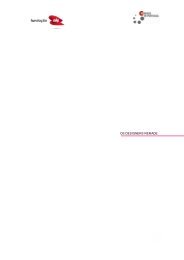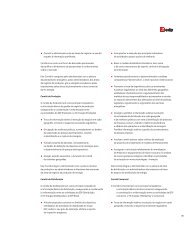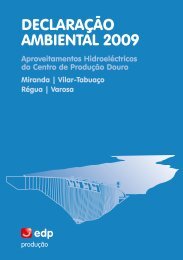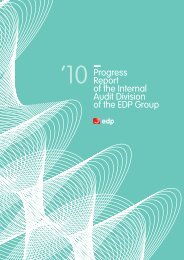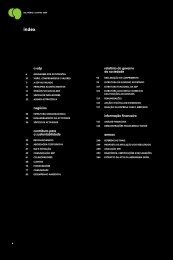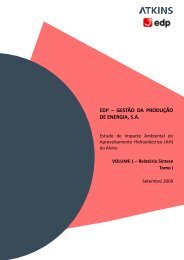Annual Report - EDP
Annual Report - EDP
Annual Report - EDP
- No tags were found...
Create successful ePaper yourself
Turn your PDF publications into a flip-book with our unique Google optimized e-Paper software.
: strategic framework :For 2013, all the end user regulated tariffs for NLVwere extinct and transitory tariffs were defined forthese customers, increasing on average by 2.8%when compared with the end user regulated tariffsof 2012. Concerning network access tariffs, theaverage prices for NLV increased by 5.2%, whilefor supplies of the remaining voltage levels theprices increased on average by 4.2%In Spain, the last resort tariffs (TUR) for residentialconsumers were quarterly updated, growing onaverage by 3.0% in 2012 versus the tariffs in thelast quarter of 2011, while the network accesstariffs have remained constant during the firstquarter of 2012. In April, in accordance with theMinisterial Order IET/843/2012, the access tariffswere increased by 7.0% for residential customers(TUR) and 4.5% for the remaining customers.Renewable energyGlobal regulatoryreviewAs part of the International commitments onreducing greenhouse gases emissions, the 2012United Nations Climate Change Conference helda meeting in Doha (Qatar) that concluded with anextension of the Kyoto Protocol (set to expire in2012) until 2020 with 37 countries (representingaround 15% of worldwide emissions) agreeingto binding greenhouses gases reduction targets.In 2015 a new Treaty with binding obligationsfor all parties should be ready so it can beoperational by 2020. Negotiations will proceedto reach a comprehensive and binding treaty fora larger number of countries, including, perhaps,the United States (that never ratified the KyotoProtocol) and Developing countries such asChina, India and Brazil.Regarding EU renewable’ policy, on March2012 the European Parliament voted in favourof setting a binding renewable energy targetfor 2030. On this regard, last December, theEuropean energy ministers gave a mandate tothe Commission to start working on a post-2020renewable energy policy framework. In thisrespect, Energy Commissioner Oettinger hadcalled for a decision on such target to be taken by2014. Note that the European Renewable EnergyCouncil is calling for a binding 45% renewableenergy target for 2030.On January 1, 2013, the US Congress approved“the American Taxpayer Relief Act” that includedan extension of the PTC for wind, including thepossibility of the 30% Investment Tax Creditinstead of the PTC. Congress set a new expirationdate of December 31, 2013 and changed thequalification criteria (projects can now qualify aslong as they are under construction by the yearenddeadline).Regulatory developmentfor the framework of theelectricity sector in BrazilIn November and December of 2011 after theending of the Public Hearings (AP 040 and 120,both of 2010), ANEEL defined the methodologyfor the Third Cycle of Tariffs Revision that is to beapplied to the distributors. The methodology waspublished after the tariff revising date of somecompanies. Therefore, the ANEEL administrationdecided that the companies with tariffs revisionsplanned for the period between 2011 andFebruary 2012 should have their tariffs prorogueduntil the next planned tariffs revision, but therevised tariffs should have a retroactive effect inrelation to the previous revision date.The year of 2012 was marked by significantchanges in the electric energy sector regulations.Among them is the Provisory Measure n. 579/2012,30in which the federal government presentedmeasures in order to reduce the electricityenergy bills. The estimated average reductionfor the entire country is 20.2%, as consequenceof governmental actions on two different fronts:Sector-specific burden (7%) and Concessions’Renewals (13%).Concerning sector-specific burden, the tariffcover related to the Conta de Consumo deCombustíveis (CCC) and to the Reserva Global deReversão (RGR) will no more be transferred by thedistributors to the consumers and the Conta deDesenvolvimento Energético (CDE) will be initiallyreduced by 75% of its current value.With regard to Concessions’ Renewals, thegeneration concessionaires that have theircontracts expiring between 2015 and 2017 willbe able to renew their concessions and shallmake available their guarantee of physical energyfor the quotas system. The quotas are to bedistributed proportionally to the market size ofeach distributor, impacting the energy acquisition.The transmission concessionaires that have theircontracts expiring between 2015 and 2017 will beable to renew their concessions and, consideringthat the assets bounded to the electricitytransmission service are totally depreciated, onlythe O&M costs will be considered for the annualallowed revenues calculation.These effects will be acknowledge by theconsumers from February 2013, when all theenergy distributors have an extraordinary tariffsrevision, which is a specific revision that willadjust the energy, transmission and sectorspecificburden costs. Therefore, simultaneously,the uncontrollable costs and the supply tariffs willbe reduced, without impacting the distributors’business margins.Given that the hydroelectric generationconcessions owned by <strong>EDP</strong> – Energias doBrasil were granted after February 1995, dateof entry into force of the Law 8.987, they willnot be impacted by the regulatory modificationsthat have been defined. Meanwhile, thesemodifications should influence the rules that willbe applied to these concessions prorogationsin the future, taking into account the currentestablished conditions:º º Each hydroelectric plant should beremunerated by a tariff calculated by ANEEL.º º Power selling (certificate named GarantiaFísica) should be done taking into accountquotas of production dedicated to the regulatedsector, i.e. to the distributors.º º Compliance with the quality of servicestandards determined by ANEEL.2.2. strategicagenda2.2.1. fulfilment ofstrategic guidelines2009-2012The 2009-2012 period was marked by thesuccessful accomplishment of the strategicagenda, which has been focused essentially on,implementing low risk growth opportunities andon positioning <strong>EDP</strong> as a reference in terms ofefficiency. In this sense, the strategic architecturedefined in 2006, which stands in three axes -Controlled Risk, Superior Efficiency and FocusedGrowth -, has proven to be adequate under thecurrent framework.A World Full Of Energy







